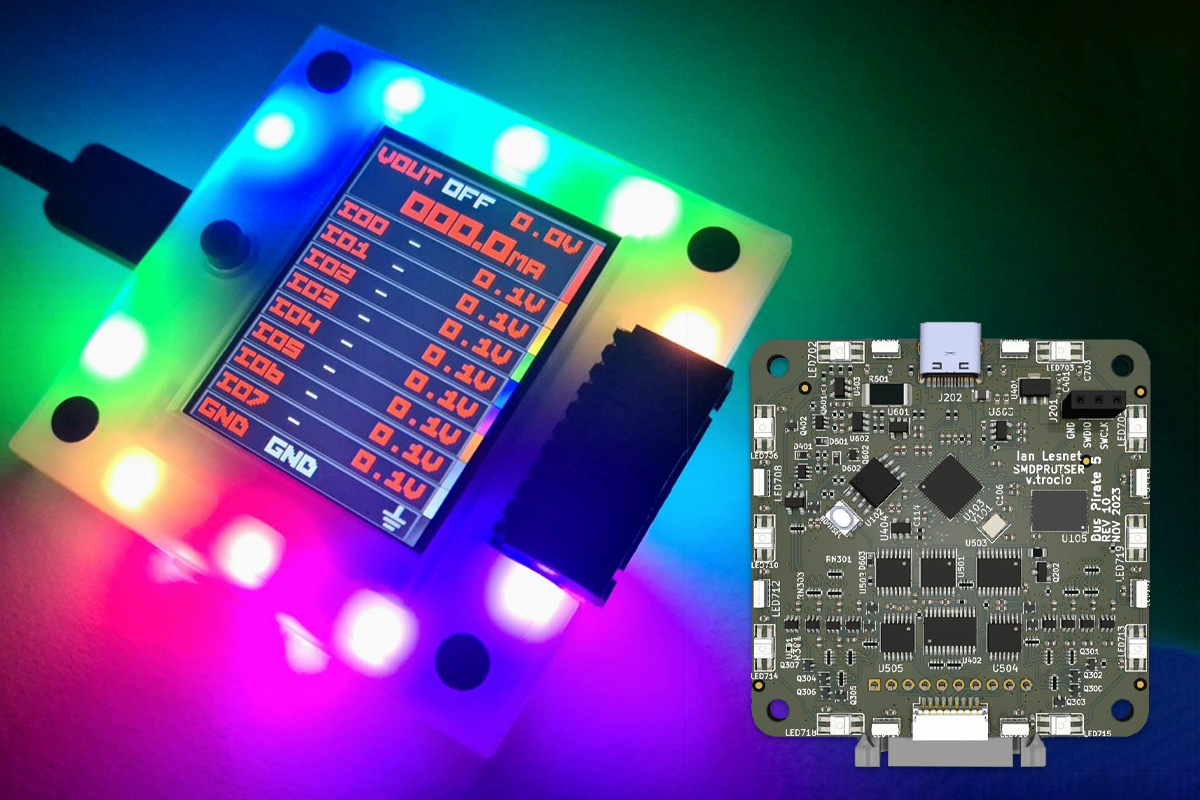CiferTech has recently introduced the nRFBOX V2 ESP32-based wireless hacking tool designed for spectrum analysis, jamming, BLE device emulation, and more. The device is built around an ESP32-WROOM-32U module and includes an NRF24 module covering the whole 2.4GHz spectrum. Additionally, the device has a 0.96-inch OLED display, a five-way microswitch control pad, and a WS2812 RGB LED for feedback. The device can also be operated with a single 3.7V lithium battery, and that batter’s charging is handled by a TP4056 charging IC. All these features make this device useful for wireless security testing, educational environments, research, and hobbyist projects. Previously we have written about similar portable hacking tools like the DSTIKE Deauther Watch X, the HackBat pen-testing device, and the popular Flipper Zero wireless hacking tool. Feel free to check those out if you are looking for similar products. nRFBOX V2 specifications Microcontroller – ESP32-WROOM-32U with ESP32 dual-core wireless microcontroller […]
MIKRIK V2 Robot Car is an entry-level, open-source robotics kit built for ROS and 3D computer vision
The MIKRIK V2 Robot Car is an open-source robotics kit for studying 3D computer vision and is compatible with both ROS1 and ROS2 software suites. The two-wheel-drive robot is powered by a Raspberry Pi 4 Model B (as a ROS1 differential drive controller) and a more powerful x86 or ARM single-board computer that can support ROS2 applications like the LattePanda Delta 3, Intel NUC, or NVIDIA Jetson Nano. The robot car uses the Intel Realsense D435i camera for 3D depth vision. It is a less expensive alternative to the iRobot Create, Husarion, and TurtleBot, and compares favorably with NVIDIA’s open-source JetBot AI robot platform. The robot car’s chassis is squared-off and made from shatterproof flex plastic. The CAD files are available on GitHub for self-assembly using a laser cutter and a 3D printer. The assembly and setup process is documented on the Hackster project page. On the software end, it […]
Android 15 source code pushed to AOSP
Android 15 will only become available on supported Pixel devices in the coming weeks, and on other phones in the next couple of months, but Google has already pushed Android 15 source code to AOSP (the Android Open-Source Project). We already documented some of the main changes in Android 15 when the first developer preview was released in February 2024. These included improvements related to privacy and security, the addition of the partial screen-sharing feature, camera and audio improvements, and some performance optimizations. You should be able to retrieve the Android 15 source code from AOSP with the following commands:
|
1 2 |
repo init --partial-clone -b android-15.0.0_r1 -u https://android.googlesource.com/platform/manifest repo sync -c -j8 |
Android 15 is based on Linux 6.6 LTS, so Android 15 SDKs from silicon vendors will likely be offered with Linux 6.6, although I can see Linux 6.1 is also an option. It’s also possible to browse Android 15 source code without downloading several GB of data to your […]
Edgeberry allows you to build and manage Raspberry Pi IoT Edge devices
The EdgeBerry is an open-source platform that comprises a base board, hardware cartridges, and software for building Raspberry Pi IoT Edge solutions designed by Belgium-based maker, Sanne Santens. The Edgeberry Base Board is the primary printed circuit board that connects all the other components to the Raspberry Pi. While it is not a HAT (Hardware Attached on Top), it plugs into the GPIO header on the Pi and provides certain interfaces and features that make it easier to use your Raspberry Pi as an IoT Edge device and deploy it in the real world. Unused GPIO pins are exposed on the expansion slot for Edgeberry Hardware Cartridges. Edgeberry Base Board specifications: 40-pin GPIO connector for interfacing with the Raspberry Pi Expansion slot for connecting Edgeberry Hardware Cartridges Misc – Buzzer, Bi-color LED, Button 3A step-down converter 12V DC power jack A unique advantage of the Edgeberry platform is the ability […]
Integrated motor driver and controller bundles ESP32-S3 and TMC2209 for IoT applications
The PD Stepper is a NEMA 17 integrated stepper motor driver and controller board powered by USB power delivery that combines an ESP32-S3 wireless microcontroller, the Trinamic TMC2209 ultra-silent motor driver, and other components onto a single board for Smart Home and automation applications. The maker, Josh R., states that the PD Stepper isn’t another “just because we can” project. It addresses the need for an integrated motor driver and controller module that can used in compact or space-constrained designs. The ESP32-S3 SoC controls the other components on the board and provides wireless connectivity as well as access to development tools and libraries such as ESPHome and ESP-Now. The motor driver IC, Analog Devices’s Trinamic TMC2209, offers efficient, noiseless control of two-phase stepper motors. Other onboard components and connectors include an AS5600 magnetic rotary position sensor, a 3.3V buck converter, a Qwiic/Stemma QT connector, a motor connector, and an AUX […]
ESP8266-powered Netgotchi network security scanner aims to protect your home network
The Netgotchi network security scanner is a simple, compact device based on an ESP8266 wireless microcontroller with a single goal: to defend your home network from intruders and potential bad actors. It is described as “Pwnagotchi’s older brother,” a network guardian that keeps your network safe instead of penetrating it. If you are unfamiliar with Pwnagotchi, it is an A2C-based (advantage actor-critic) “AI” that can penetrate Wi-Fi networks using WPA key material obtained from passive sniffing or de-authentication attacks. The Netgotchi is a reverse Pwnagotchi that alerts you to intruders or breaches in your network. It runs on a simple microcontroller and cannot employ reinforcement learning like the Pwnagotchi. Rather, it pings the network periodically and reports any new potential security threats. The device’s design is as simple as its purpose. It is an ESP8266 microcontroller connected to an OLED display and running an Arduino .ino script, enclosed in a […]
ANAVI Dev Mic is a digital omnidirectional microphone based on Raspberry Pi RP2040 MCU (Crowdfunding)
The ANAVI Dev Mic is an open-source microphone board from ANAVI Technology in Plovdiv, Bulgaria powered by the Seeed Studio XIAO RP2040 module and an omnidirectional digital microphone from STMicroelectronics. It is a compact and affordable product that outperforms USB microphones in artificial intelligence and machine learning voice applications. The design is simple and unassuming, with the Seeed Studio XIAO RP2040 module in the center, surrounded by a USB-C port for power and programming and 9 GPIO pins for extensibility. The STMicroelectronics MP23DB01HP microphone (MK1) is mounted on the top of the board with a small hole on the bottom. It is a compact, low-power, digital MEMS microphone capable of capturing sounds from different directions with very low distortion. It uses a PDM (Pulse-Density Modulation) interface created via the programmable inputs/outputs (PIO) on the RP2040. The ANAVI Dev Mic is applicable for conducting AI/ML research, building a voice recognition platform, […]
Bus Pirate 5XL and 6 hardware debugging tools utilize Raspberry Pi RP2350A and RP2350B microcontrollers
The Bus Pirate 5XL and 6 are open-source hardware debugging tools respectively based on Raspberry Pi RP2350A and RP2350B and designed to simplify interaction with various bus protocols like 1-Wire, I2C, SPI, UART, several LEDs, and more. The idea is to send commands to a chip or sensor and get the response, without writing a single line of code making it ideal for hardware hacking and tinkering. The devices feature buffered I/O pins with voltage and current measurement, a programmable power supply with current limiting, an RGB LCD for pin status and info, and an auxiliary header for connecting logic analyzers. All these features make this device useful for applications like debugging circuits, prototyping projects, and reverse engineering devices. The new devices are updates to the Bus Pirate 5 based on Raspberry Pi RP2040 MCU. You’ll find Bus Pirate specifications for the three models in the table below. The original […]










